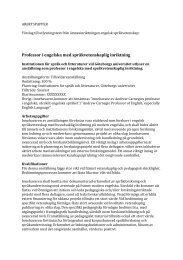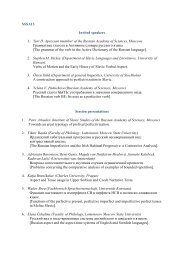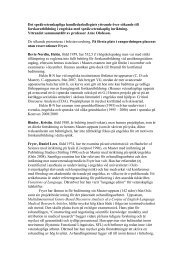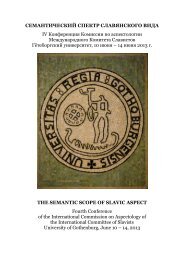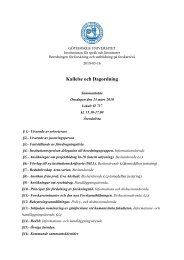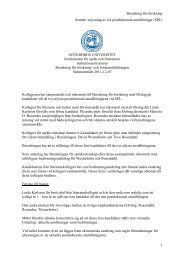Tawada’s work appeared in Swedish translation, entitled Talisman, in 2009. The Swedish Talismanincludes both German Talisman 1996 and Verwandlungen 1998. 17 The German Talismanis a collection of essays, where the first person narrator is to be read identical with the author.A short notice at the back of the Swedish Talisman also invites the readership to read it as such,saying that the author tells as ‘an ethnologist’ about a foreign country (meaning Germany), studyingit with an intentionally naïve eyes’. Verwandlungen includes a series of lectures Tawada gavein Tübingen, along with some essays, which also circles around the question of language andsubjectivity.In these texts, Tawada scrutinizes her meeting with German language and culture, presentingan interesting, somewhat instable positioning in between Japanese and German. Her texts showtellingly that a transcultural stance and subjectivity cannot be internalized straightforwardly,but, rather, it is a process, which starts with an altered self-consciousness of an individual vis-àvisown language and culture, and, leads successively to a space that is neither in or out of ownor foreign culture but, so to speak, to the third place. (Third, in a figurative sense, because in acase, where an individual moves among three languages, it should be called the fourth place.)The third position/place is, as mentioned, a figurative place from where the individual seemsable to objectify both his/her own and the other’s language and culture. Mother tongue is amorphous,Sakai pointed out, and a native uses without having any conception of its grammaticality.18 Tawada describes the moment, when an individual gets conscious of, and is awakened from,this amorphous state,(German) words that came out of my mouth did not express what I felt. Besides, I realized thatI could not find, even in my mother tongue, words that expressed my feelings. It is just that I neverfelt this way before living using a foreign language. 19 (37)To live in a foreign language, surrounded by it and using it, sharpens the sensibility towardlanguage in general, and also toward own mother tongue. The mother tongue ceases to be atransparent medium of communication. The mother tongue acquires an opacity and foreignness.In other words, it becomes a poetic language, pregnant of abysses and dissonances, void of the illusionof oneness of words and the world. This sense of split between language and the real is animportant site, not only of the poetics, but also, more fundamentally, of critical objectivity to besets in motion. The sense of disaccord of words and reality (like feelings) gives the subject a reflective,critical position toward both language and the real that is denoted by language. Tawadacontinues,I was often caught of disgust against those who spoke their mother tongue fluently. Theygave me an impression of being incapable of thinking or feeling anything other than what theirlanguage swiftly and easily delivered. 2017 Talisman. 2009. Translated by Linda Östergaad. Ariel Skrifter 44. Stockholm: Ariel. Unfortunately, theyears of publication of German originals are reversed and said Talisman 1998 and Verwandlungen 1996.18 Regarding literacy in Japan and mother tongue, see Sakai, Naoki. 1997. Translation and Subjectivity.Minneapolis, London: University of Minnesota Press. 20-22. He pointed out the mother tongue’s amorphousnature. However, the focus of his dicussion lies more how the mother tongue emerged historicallyclosely tied with national identity since the 19th century in Japan (21).19 Talisman, 37.20 Talisman. 2009, 37. More mention about the transparency of the mother tongue, see Talisman. 2009,Literature and Transculturality7
To live surrounded by, and using, a foreign language, opens up the third place, which seems animportant premise of constructing the subject position that is not caught innocently in onenesswith the mother tongue.As a new language learner, the author is sensitive to the differences of the two languages, Japaneseand German. Japanese constitutes a point of reference, but it is the meeting itself that makesJapanese visible. 21In “From the mother tongue to the mother of tongue” (Från modersmålet till språkmoder)” inTalisman, the narrator ‘I’ is keenly aware of the foreignness of the new language, German, to thedegree that a pencil in Japanese and German, enpitsu and Bleistift, seemed to her two differentcategories. (7) When she comments the outburst of her German colleague at the office, whereshe works, and compares it to general Japanese attitude towards things, it sounds like a reversedOrientalism. German nouns have three genders, masculine, feminine and neutral. As a Japanese,she is enhanced with the sex of things, and a sterile office landscape opens up an almost fantasticscene for her. She establishes a personal relationship with everyday things around her. A typewriteris feminine, which makes her feel a personal tie, when writing on the machine, the foreignlanguage. The typewriter, due to its stable, inviting feminine form, as she sees, and its grammaticalgender, becomes the mother of her new language, giving her a sense of being ‘adopted’ by thelanguageAcquisition of a new language is compared to a child’s learning the mother tongue, wherewords, cut off of semantic connotations and syntactical chains, can fly free in fantasy. (10-11)This is a freedom in language, liberating the language from its everydayness.Not only meeting the new language with the eyes of a marveled child, her method of acquisitionis physical. Vision plays a role, for instance the shape of the consonant ‘s’ on a poster at abuss stop in Hamburg, which seduced the author. (35) But she seems more keenly sensitive toears and hearing. Meeting with the foreign language seems to have bestowed her with a newself-consciousness regarding the act of hearing. The episode of a Tibetan monk is telling. Theauthor heard a monk recite a prayer in a temple in Tibet, which gave her the sensation of hearingmultiple voices in one voice. (22-23) In the monk’s voice, the author believed hearing the voice ofthe dead. She recounts more lengthily the episode in “Others’ timber (Andras klang)” (92-102),where she also tells about own ‘sound-memory’ since the childhood in Japan. Regarding the Tibetanmonk, the author asks, “Why do we not hear several voices in a voice, when they are actuallythere?” (94) She tries herself to simultaneously produce multiple tones. To believe that one’sown voice does not have one clear tone, but contains other voices like that of the dead, showsthat the author’s subjective position is no longer clearly enclosed, but open for multiplicity. Theawareness of manifoldness of one’s own voice figuratively informs the position of subjectivity ofthe author, which cannot be identified by nationality or the mother tongue. This sense of manifoldness,without any clear-cut sense of identity, should be called, in my opinion, the ‘transcultural’positioning of the subjective. Her utterance is not anchored in any homeland but open to8130. All English translations of her text are mine.21 See Sakai and note 21.Noriko Takei-Thunman
- Page 1: Cultural TranslationsProceedings of
- Page 4 and 5: PrefaceThe idea of organizing a wor
- Page 6 and 7: ContentsAcknowledgementIIPrefaceIII
- Page 8 and 9: Literature and Transculturality:Som
- Page 10 and 11: agenda of Herder, which was to figh
- Page 12 and 13: nomenon. However, until long into t
- Page 16 and 17: multiple interpretations. Japan is
- Page 18 and 19: Cultural Translation between Tradit
- Page 20 and 21: George P. Murdock illustrated the p
- Page 22 and 23: ancestor of the Maori arrived in Ao
- Page 24 and 25: nal names do not necessarily have.
- Page 26 and 27: One of the functions of ‘cultural
- Page 28 and 29: PRELUDEIn 2003, an original artisti
- Page 30 and 31: planted, adopted and fused with ind
- Page 32 and 33: liest known written clues regarding
- Page 34 and 35: since there are many Asians and Pac
- Page 36 and 37: listening to and evaluating sounds
- Page 38 and 39: Ensemble, and the Moscow Pan-Asian
- Page 40 and 41: temporary Finnish folk music. 29I a
- Page 42 and 43: Although some space for improvisati
- Page 44 and 45: whom have devoted many years to ser
- Page 46: POSTLUDEBy way of conclusion, allow
- Page 49 and 50: IntroductionThe aim of this paper i
- Page 51 and 52: to discuss what role Japan was to p
- Page 53 and 54: I may be allowed henceforth to use
- Page 55 and 56: program was to promote and help stu
- Page 57 and 58: 50different of that of Millán -Ast
- Page 59 and 60: most impracticable people in the ea
- Page 61 and 62: intending to give the Book a quasi
- Page 63 and 64: understood by the West on a time wh
- Page 65 and 66:
FUJIWARA Masahiko. (2008) Kokka no
- Page 67:
- (2002) Cultural light, political
- Page 70 and 71:
Translation, or better, linguistic
- Page 72 and 73:
one may not expect anything other t
- Page 74 and 75:
as Murakami opts for a globalized v
- Page 76 and 77:
market. 17 Another indispensable to
- Page 78 and 79:
(This is part of my doctoral thesis
- Page 80 and 81:
elieve advances man’s progress he
- Page 82 and 83:
ender the New Testament into Japane
- Page 84 and 85:
a synonym for kami. The latter is a
- Page 86 and 87:
The American school text is in the
- Page 88 and 89:
Willson Reader 46 T73 47I will not
- Page 90 and 91:
Gentlzer, Edwin & Tymoczko, Maria 2
- Page 92 and 93:
Tea ceremony or tea cult?Translatin
- Page 94 and 95:
Company (VOC), men came from differ
- Page 96 and 97:
H. Stolpe gathered items in Japan f
- Page 98 and 99:
simple presentations had negative i
- Page 100 and 101:
theticism, with its manifold bearin
- Page 102 and 103:
Kumakura, Isao (1980) 近 代 茶
- Page 104 and 105:
1. Introduction and aim of the pape
- Page 106 and 107:
main character and the caller doesn
- Page 108 and 109:
not” and ”at present” that ha
- Page 110 and 111:
match this name, a sea as artificia
- Page 112 and 113:
I John Gabriel BorkmanHenrik Ibsen
- Page 114 and 115:
his dream during the 1870s, when ca
- Page 116 and 117:
make a decision. But it turns out t
- Page 118 and 119:
Ôgai’s change of translation str
- Page 120 and 121:
Behind every utterance lies two mot
- Page 122 and 123:
a large group of persons be gathere
- Page 124 and 125:
The “Territory of Translation”
- Page 126 and 127:
八 十 日 間 世 界 一 周 :
- Page 128 and 129:
heuristic tools, especially conside
- Page 130 and 131:
Left: Photo of Kawashima Chūnosuke
- Page 132 and 133:
Burlington Gardens is in London (Ro
- Page 134 and 135:
門 アリ 入 リテ 見 レバ
- Page 136 and 137:
scene seems to be merely one of man
- Page 138 and 139:
Niwa Jun’ichirō’s Spring Tale
- Page 140 and 141:
The text is full of detailed descri
- Page 142 and 143:
where the narrative voice does not
- Page 144 and 145:
The reason the “territory of tran
- Page 146 and 147:
Translating the Trip Around the Wor
- Page 148 and 149:
ForwordI have been working on my do
- Page 150 and 151:
clining though. By the end of 1980
- Page 152 and 153:
幸 い 神 の 怒 りは 鎮 ま
- Page 154 and 155:
The Public Sphere as Deliberation o
- Page 156 and 157:
and absence of hierarchy would have
- Page 158 and 159:
was used much like we would use “
- Page 160 and 161:
outcasts and bandits - were suppose
- Page 162 and 163:
cal sense, the arena where particip
- Page 164 and 165:
society” and in which “there wa
- Page 166 and 167:
sic formulations, the public sphere
- Page 168 and 169:
はじめに日 本 統 治 下 の
- Page 170 and 171:
似 地 一 下 一 下 拽 那 鼻
- Page 172 and 173:
ということから、 古 丁
- Page 174 and 175:
の「 序 」で、 大 東 亜
- Page 176 and 177:
3.1 翻 訳 と 満 洲 国 語 政
- Page 178 and 179:
取 り 入 れを 主 張 する
- Page 180 and 181:
文 化 の 翻 訳 としての「
- Page 182 and 183:
史 性 にも 留 意 すべきだ
- Page 184 and 185:
て、 渦 巻 きよりほかは
- Page 186 and 187:
変 わらないということも
- Page 188 and 189:
訳 語 と 新 語 から 見 る
- Page 190 and 191:
しは「 無 為 」や「 本 性
- Page 192 and 193:
思 想 を 基 礎 として、
- Page 194 and 195:
って「 物 理 上 哲 学 」
- Page 196 and 197:
し、まさにはこの 時 期
- Page 198 and 199:
意 譯 : 理 學 、 性傅 汛
- Page 200 and 201:
柴 田 昌『 增 補 訂 正 英
- Page 202 and 203:
一 八 七 七 年 、 文 部 省
- Page 204 and 205:
日 中 友 好 の 象 徴 「 鑑
- Page 206 and 207:
と 指 摘 した。成 吉 思
- Page 208 and 209:
をあげている。さらにま
- Page 210 and 211:
に 請 ひて 出 家 を 求 む
- Page 212 and 213:
この 時 奉 請 の 十 師 等
- Page 214 and 215:
歴 史 小 説 『 天 平 の 甍
- Page 216 and 217:
点 」が 生 じたと 指 摘
- Page 218 and 219:
まず、 昨 今 、 活 発 に
- Page 220 and 221:
2、 従 来 の 比 較 文 学 (c
- Page 222 and 223:
普 遍 理 論 を 適 用 し、
- Page 224 and 225:
ス・テグネル(Esaias Tegnér,
- Page 226 and 227:
に 満 ちる「 生 命 」に
- Page 228 and 229:
う 形 をとって 展 開 した
- Page 230:
学 が 大 学 で 展 開 して



